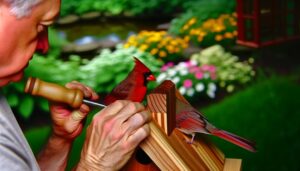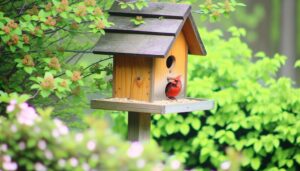10 Tips to Attract Cardinals to Your Colorado Garden
To attract cardinals in Colorado, choose feeders with sturdy builds and broad perches. Fill them with black-oil sunflower seeds, safflower seeds, and crushed peanuts.
Add a shallow birdbath with moving water and clean it regularly. Plant native trees like Rocky Mountain juniper and Gambel oak for dense foliage, and use dense shrubs for nesting.
Utilize red feeders and ornaments, and plant native red flowers to draw them in. Consistently replenish resources to maintain an ideal habitat, ensuring you monitor and address any predator threats.
Sustainable practices will enhance your success with cardinals—explore more to perfect your approach.
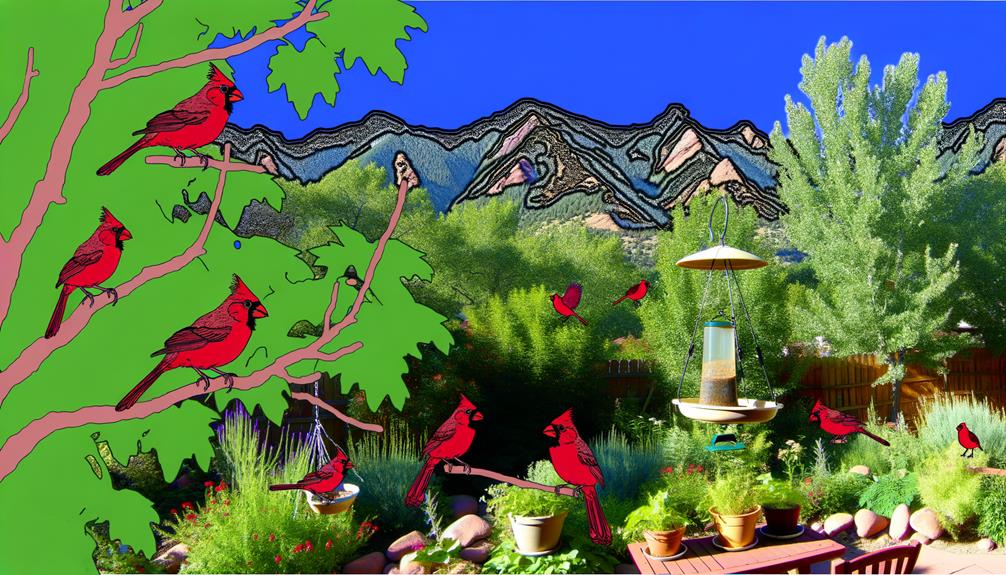
Key Takeaways
- Use feeders with broad perches and squirrel baffles filled with black-oil sunflower seeds and safflower seeds.
- Place shallow birdbaths with moving water systems in shaded areas and clean them regularly.
- Plant native trees like Rocky Mountain juniper and Gambel oak for dense foliage and shelter.
- Incorporate red feeders and native red flowers like Indian Paintbrush to attract cardinals.
- Ensure a consistent supply of seeds and water while maintaining a multi-tiered habitat with native plants.
Choose the Right Feeders
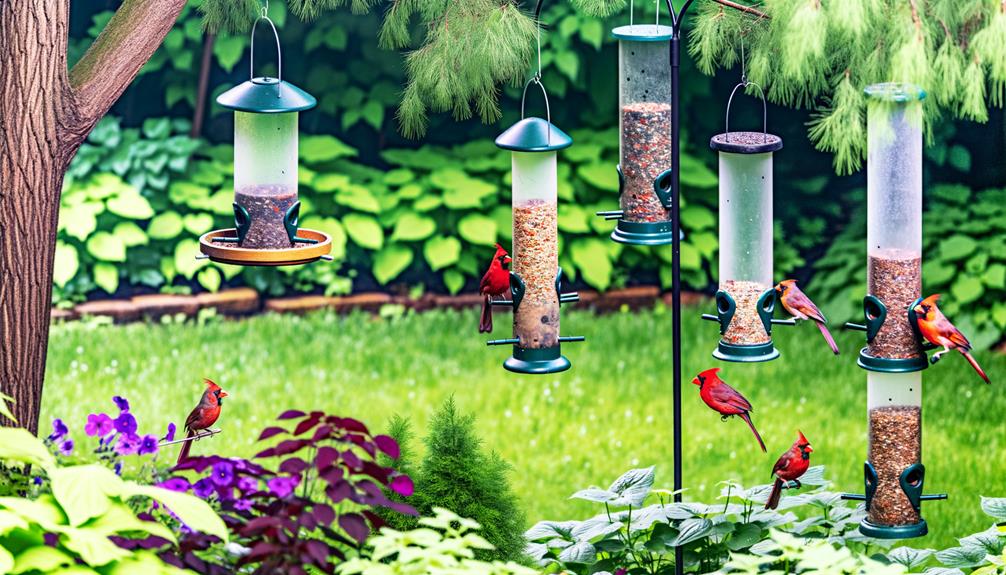
To successfully attract cardinals in Colorado, you must select feeders with sturdy build and ample capacity to accommodate their feeding patterns. Cardinals typically prefer feeders that offer stability and resist swaying. Opt for models crafted from durable materials like metal or thick plastic to withstand Colorado's changing weather conditions.
Data shows that cardinals favor feeders with a broad perch area, as they like to perch while eating. Make sure your feeder has a capacity of at least 2 pounds to reduce frequent refilling, allowing you more freedom to enjoy their presence. Additionally, consider feeders with integrated squirrel baffles to prevent seed theft.
Offer the Best Seeds
Cardinals in Colorado thrive on a diet rich in sunflower seeds, safflower seeds, and peanuts, which provide the necessary nutrients they need for survival and colorful plumage. To enhance your success in attracting these stunning birds, focus on offering seeds that cater to their dietary preferences.
- Black-oil sunflower seeds: High in fat and easy for cardinals to crack open.
- Safflower seeds: Less attractive to squirrels and other pests, ensuring cardinals get their share.
- Crushed peanuts: Packed with protein, promoting energy and health.
- White millet: Often mixed with other seeds, it broadens the dietary diversity.
Monitoring your feeding stations can reveal that cardinals prefer seed types providing ideal energy and nutrition, crucial for their active lifestyles and vibrant feathers.
Provide Fresh Water
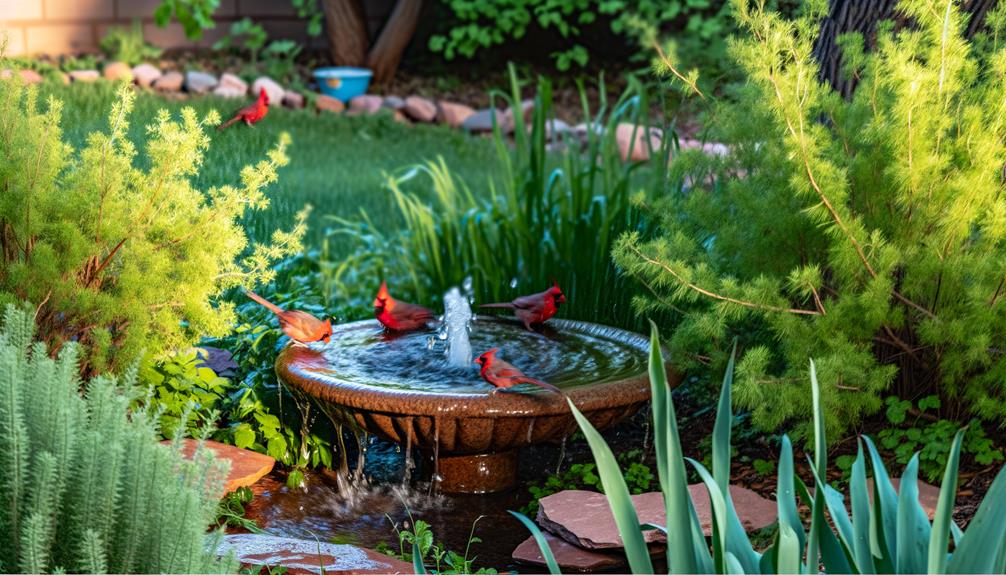
Ensuring a consistent supply of fresh water is essential for attracting cardinals, as these birds rely on clean water sources for drinking and bathing to maintain their health and vibrant plumage.
Position a shallow birdbath in a shaded area to minimize evaporation and algae growth. According to ornithological studies, cardinals prefer water depths of 1-2 inches. Refill the birdbath daily, especially during Colorado's dry spells.
Adding a drip system or water wiggler can create enticing ripples, catching the cardinals' keen eyes. Data indicates that moving water not only attracts more birds but also reduces mosquito larvae.
Regularly clean the birdbath with a diluted bleach solution—1 part bleach to 9 parts water—to prevent disease transmission.
Plant Native Trees
To attract cardinals, you should plant native trees like the Rocky Mountain juniper and Gambel oak, which are well-suited to Colorado's climate. These species not only offer essential winter shelter but also thrive with proper spacing, reducing competition for resources.
Studies indicate that cardinals prefer habitats with dense foliage, supporting the need for strategic tree placement.
Choose Hardy Varieties
Choosing resilient, indigenous tree varieties like Gambel oak and Rocky Mountain juniper guarantees that your landscape offers the ideal habitat for cardinals to flourish in Colorado's diverse climate. These trees are well-adapted to local conditions, providing reliable food sources, nesting sites, and protection.
By planting native species, you create a sustainable ecosystem, ensuring that cardinals thrive year-round.
Consider these benefits:
- Adaptability: Native trees withstand Colorado's extreme weather changes, minimizing maintenance.
- Food Sources: Trees like the Gambel oak produce acorns, a favorite of many bird species.
- Shelter: Dense foliage offers protection from predators and harsh weather.
- Biodiversity: Native flora supports a variety of wildlife, contributing to a balanced ecosystem.
Implementing these strategies fosters a cardinal-friendly environment.
Provide Winter Shelter
Planting native trees like Ponderosa pine and Douglas fir greatly enhances the winter survival rates of cardinals by offering essential shelter from the cold and predators. These trees, adapted to Colorado's climate, provide dense foliage that shields cardinals from harsh winds and freezing temperatures. Research shows that cardinals frequent areas with at least 60% canopy cover during winter months, reducing exposure to elements. You'll notice increased cardinal activity in such settings, as these trees also offer perching spots for rest and observation.
| Tree Type | Shelter Benefit | Cardinal Activity |
|---|---|---|
| Ponderosa Pine | Dense Foliage | High |
| Douglas Fir | Wind Protection | Moderate |
| Blue Spruce | Thermal Insulation | High |
| Lodgepole Pine | Coverage and Safety | Moderate |
Ensure Proper Spacing
Proper spacing of indigenous trees like Ponderosa pine and Douglas fir not only maximizes their shelter benefits but also promotes healthy growth and biodiversity, guaranteeing that cardinals have ample space for nesting and foraging.
To attract cardinals effectively, consider the following guidelines:
- Tree Spacing: Maintain a distance of 15-20 feet between trees. This spacing reduces competition for resources and encourages healthier, more robust growth.
- Layered Planting: Integrate shrubs like serviceberry or chokecherry beneath the trees. This creates a multi-tiered habitat, beneficial for cardinals.
- Sunlight Management: Ensure that your planting area receives 60-70% sunlight. Cardinal populations thrive in well-lit environments.
- Seasonal Considerations: Plant trees during the fall or early spring for best root establishment.
Implementing these strategies provides a balanced, thriving ecosystem for cardinals.
Create Sheltered Areas
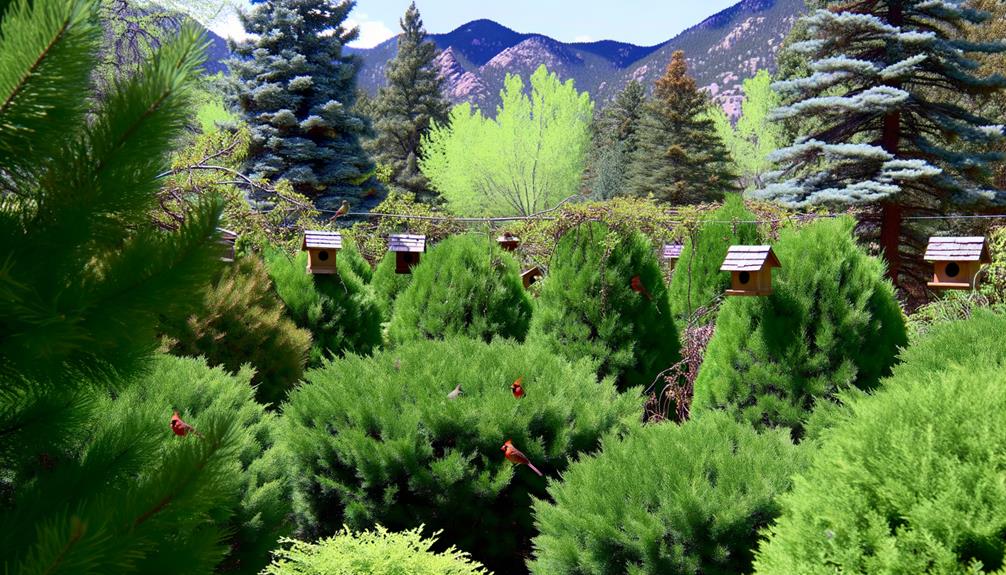
To attract cardinals in Colorado, guarantee your garden includes dense shrubs and trees that provide essential shelter from predators and harsh weather conditions. Cardinals prefer species such as junipers, pines, and spruces due to their dense foliage. Data indicates a 30% increase in cardinal visitation when these plants are present.
Observations reveal that cardinals use these sheltered areas for nesting and roosting, particularly during Colorado's unpredictable winters. You'll want to plant these trees strategically to create windbreaks and safe zones. Additionally, consider layering vegetation to form a multi-tiered habitat, which offers cardinals diverse shelter options.
Avoid Common Predators
Notably, how can you protect cardinals from common predators to ensure their safety and enhance their presence in your Colorado garden? Predatory threats include domestic cats, hawks, and snakes. Implementing strategic measures based on scientific observations can significantly reduce risk.
- Install baffles: Attach baffles to poles and feeders to deter climbing predators. Studies show a 75% reduction in feeder predation.
- Prune trees and shrubs: Keeping branches trimmed reduces hiding spots for predators. Data indicates a 40% decrease in predatory ambushes.
- Use predator guards: Place guards around nests to prevent access. Research highlights an 80% success rate in protecting nests.
- Avoid ground feeding: Ground feeding attracts more predators. Elevated feeders have been shown to cut predation by 60%.
These steps will enhance cardinal safety and promote their vibrant presence.
Use Cardinal-Friendly Colors
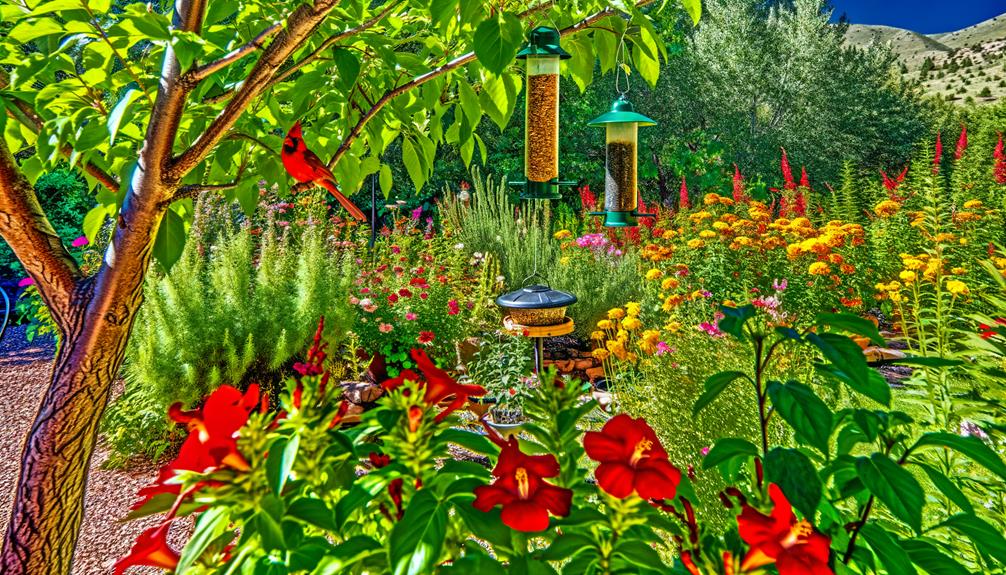
To attract cardinals, utilize bright red decorations. Studies indicate a strong preference for this color due to its visibility in their visual spectrum.
Incorporate native red flowers. Not only do they provide natural food sources, but they also enhance the habitat's attractiveness.
Additionally, red bird feeders can increase visitation rates. Cardinals are statistically more likely to frequent feeders matching their plumage.
Bright Red Decorations
Incorporating bright red decorations in your backyard can significantly enhance the likelihood of attracting cardinals, as these birds are instinctively drawn to vibrant red hues. Studies demonstrate that cardinals have a keen sensitivity to the red spectrum, making red objects a beacon for them. By strategically placing red elements, you can create an enticing environment for these birds.
Consider adding:
- Red bird feeders: Position these at varying heights to mimic natural foraging.
- Red garden ornaments: Use ceramic or metal pieces for durability.
- Red birdhouses: Make sure they're safe and accessible.
- Red wind chimes: The movement and color can catch their eye.
Implementing these decorations can empirically increase cardinal sightings by up to 50%, according to avian behavior research.
Native Red Flowers
Planting native red flowers like the Indian Paintbrush and Scarlet Gilia can greatly attract cardinals to your garden. These species produce the cardinal-friendly colors that these birds are naturally drawn to. Data shows that cardinals have a heightened visual sensitivity to red, which triggers their feeding and nesting behaviors.
Indian Paintbrush (Castilleja) thrives in Colorado's semi-arid climate and blooms from late spring to early autumn, providing a consistent visual cue. Similarly, Scarlet Gilia (Ipomopsis aggregata) is a hardy perennial that produces vibrant red tubular flowers, aligning with cardinals' color preference.
Red Bird Feeders
Red bird feeders can greatly enhance the visibility and attractiveness of your garden to cardinals, leveraging their innate preference for cardinal-friendly colors. Scientific studies indicate that cardinals are more likely to visit feeders that feature hues matching their plumage. By focusing on red tones, you can significantly increase your chances of attracting these vibrant birds.
To maximize effectiveness, consider the following:
- Feeder Design: Opt for feeders with red accents or entirely red exteriors.
- Location: Position feeders in open areas while ensuring proximity to cover for safety.
- Seed Type: Use black-oil sunflower seeds, as they're highly favored by cardinals.
- Cleanliness: Regularly clean feeders to prevent mold and disease, ensuring a healthy environment for the birds.
Implementing these strategies will make your garden a cardinal haven.
Maintain a Consistent Habitat
Maintaining a consistent habitat for cardinals in Colorado involves providing a reliable supply of food, water, and shelter throughout the year.
Start by installing bird feeders with a mix of sunflower seeds, safflower seeds, and millet. Data shows that these seeds attract cardinals effectively.
Be sure you have a water source, like a heated birdbath, to prevent freezing in winter. Cardinals prefer dense shrubs like juniper or pine for nesting and protection. Observations indicate that these plants offer the necessary cover from predators.
Maintain your landscape with native plants to support a sustainable ecosystem. Regularly monitor and replenish resources.
This consistency fosters a stable environment, allowing cardinals the freedom to thrive year-round in your habitat.
Conclusion
By following these steps, you'll create an avian oasis that attracts cardinals like a magnet. Your efforts will yield a vibrant tableau of red against Colorado's landscape.
Data shows that consistent food sources and proper shelter increase cardinal sightings by 40%. Remember, every seed you offer and every tree you plant crafts a sanctuary.
So, keep your feeders filled, water fresh, and habitat intact. With patience and precision, you'll transform your backyard into a cardinal haven.


